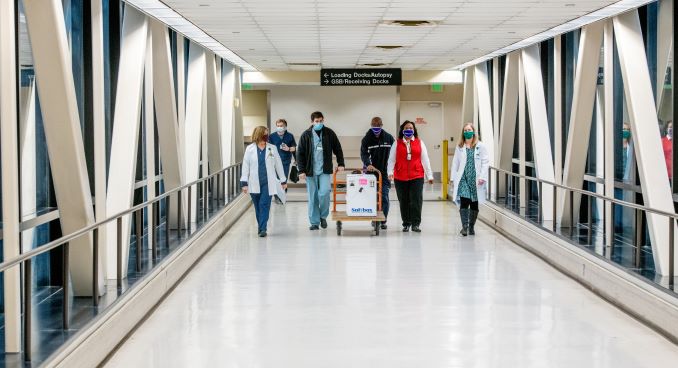 On Friday, Dec. 18, School of Medicine experts discussed the COVID-19 vaccine in a school-wide town hall.
On Friday, Dec. 18, School of Medicine experts discussed the COVID-19 vaccine in a school-wide town hall.
Co-moderated by Selwyn Vickers, M.D., dean of the School of Medicine, and Jeanne Marrazzo, M.D., director of the Division of Infectious Diseases, the town hall reviewed both the Pfizer and Moderna vaccines at-length.
Panelists involved in the one-hour long webinar included: Sarah Nafziger, M.D., professor in the Departments of Emergency Medicine and Neurology and physician advisor for the Center for Patient Flow; Latesha Elopre, M.D., assistant professor in the division of Infectious Diseases; Paul Goepfert, M.D., professor in the Division of Infectious Diseases; and Michael Saag, M.D., associate dean for Global Health and professor in the Division of Infectious Diseases.
A little over one-fourth of the state’s vaccine allocation arrived at UAB on Tuesday, Dec. 15. Panelist and moderator discussion included: the urgency of a vaccine for COVID-19, how the vaccine development process works, fears and uncertainty around the vaccine, and rollout timelines for UAB employees and community members.
In response to logistics of the vaccine for UAB, Nafziger said, “We want to make sure we get the vaccinations out in the safest manner.”
Urgency for COVID-19 therapeutics is necessary
Saag discussed the reality of COVID-19 cases and deaths, citing other national crises—such as Sept. 11, 2001 and World War I—to convey the extreme mortality rate we currently face with the pandemic. He noted the increased hospitalizations throughout Dec. 2020, and the importance of getting vaccinated when therapeutics are available for each individual group. He also noted the many diseases and viruses that have come before COVID-19, and how vaccines have saved thousands of lives in the past.
“We are in a season of miracles right now, and this [vaccine] is a modern-day miracle…Nobody would recommend a vaccine if it wasn’t effective, and certainly nobody would recommend a vaccine if wasn’t safe,” Saag said.
Scientific process behind vaccine development
Paul Goepfert, M.D., commented on the vaccine process and the many ways scientists have worked on the SARS-CoV-2 vaccine to date. He spoke into why the vaccine was able to be developed so quickly, mentioning modern technology like mRNA as one reason.
Goepfert conveyed that, because scientists knew the details of SARS-CoV-2 early on, and because of their knowledge of SARS-CoV-1 from 2003, they were able to pinpoint what pathogen to target in vaccine development. The spike protein is the “Achilles heel” in coronaviruses, and research-scientists had this information from the beginning. The immune system recognizes the spike protein of the virus. Vaccines help the body identify spike proteins early, which wards off future infection. With the vaccine, our immune system is trained to recognize the protein.
Skepticism and safety around the vaccine
From a public health standpoint, many people are concerned about safety of the vaccine. Points of hesitancy are valid. Latesha Elopre, M.D., helped viewers understand why populations across the U.S. might be hesitant due to historical reasons and unsuccessful vaccinations at a community-level in the past. She said a tailored approach is important, and should happen at multiple levels across the country. Community engagement is critical in building trust. For anyone experiencing skepticism, Elopre recommended looking to our medical leaders for education and confidence in the vaccine.
Operations and timeline of vaccination
Sarah Nafziger, M.D, discussed the differences in the influenza vaccine and the COVID-19 vaccine. She said this vaccination rollout is a bit more challenging than the flu vaccine, due to storage needs, special freezers, and temperature monitoring, as well as a number of logistics efforts.
As far as roll out information for UAB employees and community members, Nafziger said that everything changes quickly.
“Everybody is very interested in knowing when it’s going to be their turn, and anytime you have a resource like this, that’s very scarce like this one is—and you have to make decisions about who gets it first—it’s very difficult decisions to make. We don’t take that lightly.”
The CDC has recommended rolled out phases for vaccine distribution. Nafziger said UAB is currently in Phase 1 of the vaccine roll out, which includes healthcare workers and long-term care facility residents, like those in nursing homes.
Students fall into Phase 1b, and clinical-based students will be prioritized first among all students at UAB. Nafziger also noted that UAB is providing the vaccine to EMS, ambulatory-based healthcare providers, and other regional hospitals, too. Nafziger said UAB teams are making recommendations on vaccine roll out based on the question “Who has the most COVID exposure at work?”
UAB is delicately planning who will receive the vaccine and when.
Questions and answers on the vaccine
For around thirty minutes, panelists answered questions from attendees. Participants were asked to send their questions in to panelists via registration ahead of time.
Questions ranged from topics such as immunocompromised individuals, allergic response to the vaccine, and if pregnant or breastfeeding women should get the vaccine. They also discussed if previous COVID+ patients should get vaccinated and if antibodies impact a need to get the vaccine.
The vaccine is expected to be distributed to the general public by late spring or summer 2021. Neither the Alabama Department of Public Health not UAB will require the vaccine as mandatory at this time.
Watch the full town hall here: https://www.youtube.com/watch?v=JpQWgYtluvQ
For more information, visit UAB United.
